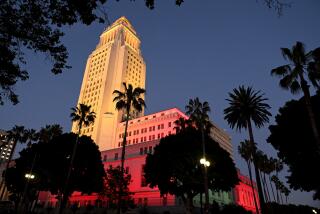Intergovernmental follies
The current flap over the University of Southern California’s threat to abandon the Coliseum and instead play football in the Rose Bowl has turned a spotlight on the nine-member Coliseum Commission which in turn allows us to unearth the rich history of one of Los Angeles’ defining and often ridiculously inept institutions: the intergovernmental agency.
When the state of California wants to unload responsibility but not power, or City Hall questions the motives of Los Angeles County but covets county property, or everyone agrees to build something but no one has enough money, the solution is often to form a new entity made up of representatives of several governments. And so we have the Coliseum Commission, which runs the Los Angeles Memorial Coliseum and the Los Angeles Sports Arena. Neither facility currently has any professional tenants.
The origins of the joint management predate plans for the Coliseum itself and are part of the history of Exposition Park. The area just south of USC was once an agricultural fairground and racetrack owned by a private entity called the Southern District Agricultural Society. It was where you would go, in the 1870s, to see displays of the most modern farm equipment or show off your prize livestock. The state began staging fairs there and eventually bought much of the land, which came under the control of a state agency known as the Sixth District Agricultural Assn.
So the state owns the land. But the Coliseum itself was built with city and county funds, raised by a nonprofit corporation created by the City Council and the Board of Supervisors. The Coliseum Commission was born in 1945 as a Joint Powers Authority made up of representatives of all three governments (the city, the county and, no kidding, the Sixth District Agricultural Authority, which in its current incarnation is the California Science Center a division of the State and Consumer Services Agency), which were to operate the stadium cooperatively.
The commission operates the facility under a state lease that doesn’t run out for another 48 years.
To be fair, the commission did a bang-up job for many decades, doing its part to convince the Cleveland Rams to move to town (in 1946) and making the more dubious decision to house the Oakland Raiders during their Los Angeles exile from 1982-1994.
But the commission has lost every team it has attracted. In recent years, the three representatives each from the city, the county and the state have accomplished little, but a seat on the commission remains a political powerbase. Mark Ridley-Thomas was giving up a lot when he left the City Council and therefore his Coliseum Commission seat to go to the state Assembly. His place was taken on the commission by Tom LaBonge, who complained bitterly when he was ousted in favor of Bernard Parks. Management of the Coliseum promises to loom large in next year’s supervisorial race between Parks and Ridley-Thomas.
A city-county-state joint-powers authority also was once instrumental in operating Olvera Street or, more accurately, the El Pueblo monument that includes Los Angeles’ historic plaza, the Street (a back alley which was re-created in the 1920s as an “authentic” Mexican marketplace), and several historic buildings.
So seamlessly did the city, county and state operate what was once known as El Pueblo State Historic Park that they together presided over the demolition of much of L.A.’s priceless architectural heritage and signed off on plans to run the Santa Ana Freeway though the core of the old city. As preservationists tried to protect what remained, and as Latinos began to claim the area as part of their heritage, the state worked to get itself out of the arrangement and reject any responsibility for the park.
Ultimately the state left and the city took over, creating a new department to manage the area. But to come to terms with Los Angeles County, the city had to relinquish jurisdiction over a collection of 18th century buildings across the street from the plaza. The county proceeded to demolish one of the buildings and currently is planning its own, competing historic plaza adjacent to the city’s version.
The postwar era was the golden age of joint-powers authorities joining some combination of the city, the county and the state. JPAs were part of a movement toward professional government in which an extra layer between voters (in other words, politics and campaign donations) and management was deemed in the best interests of all. If only the city ran the Los Angeles Convention Center, for example, management might too easily become entangled in city politics. But if the center were divided among the city and county, with state oversight as well, no single politician or political body could mess things up.
That kind of thinking fell out of fashion beginning in the late 1970s. Multiple agencies were deemed multiple bureaucracies, run by too many people with no incentive to take responsibility but every incentive to say no. Joint-powers authorities began to wane.
Or perhaps they just took new forms. L.A.’s Entertainment Industry Development Corp. was not exactly a JPA, but it was a prime example of an even more disastrous type of city-county cooperation. The Board of Supervisors and the City Council figured that instead of each entity working against the other to attract the movie industry and to administer film location permitting, they ought to create a corporation that would be overseen by all of the elected officials as one big happy family.
Perhaps you remember the rest. The EIDC had board meetings, but none of the elected officials attended because they trusted their top staffer, Cody Cluff, to take care of business. Cluff did indeed take care of business, mostly his own, using the corporation’s permit fees on trips, country club memberships, entertainment at strip clubs and oh, by the way, political donations to board members’ reelection campaigns. Members of the City Council and Board of Supervisors were outraged, of course, until reminded that they each in effect signed off on all the expenses by not showing up to EIDC board meetings to question Cluff’s actions.
Then there is the Los Angeles Homeless Services Authority, formed by the city and the county to work together which by now you should know is another way of saying “to keep an eye on each other” to end homelessness in the city.
In its first decade, LAHSA was a fiasco. Its existence allowed both city and county officials to shirk responsibility for homelessness by claiming either that the authority was taking care of things or that the other guys (city or county) were trying to control LAHSA and thus preventing the good guys (county or city) from getting anything done.
It’s a new day at LAHSA, with new leadership, and claims from both City Hall and the county Hall of Administration that the authority has an invigorated role in fostering cooperation. If only the (your choice: city/county) would allow it to do its work.
Robert Greene is a member of The Times’ editorial board.
Send us your thoughts at [email protected].
More to Read
A cure for the common opinion
Get thought-provoking perspectives with our weekly newsletter.
You may occasionally receive promotional content from the Los Angeles Times.











